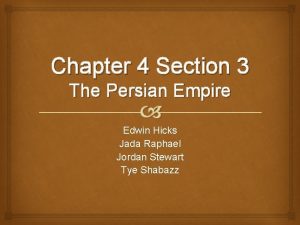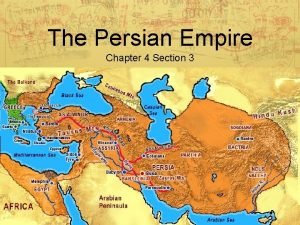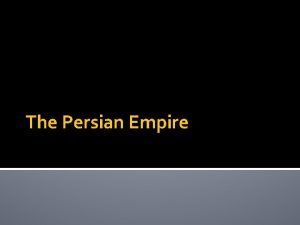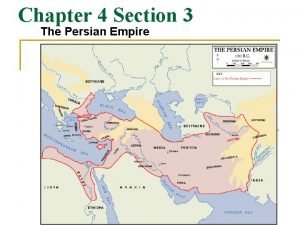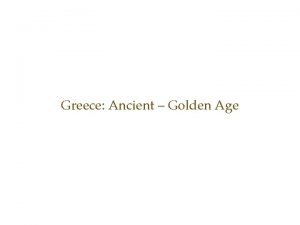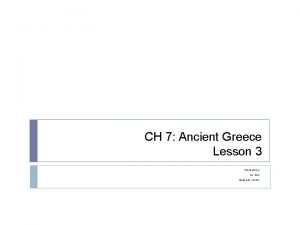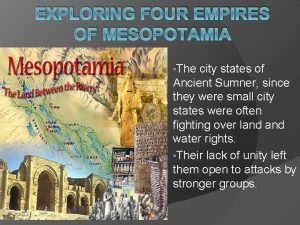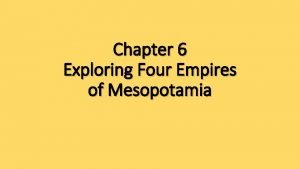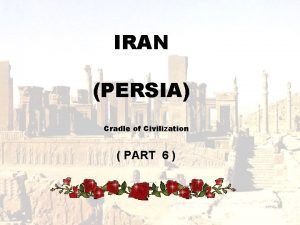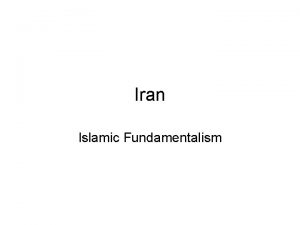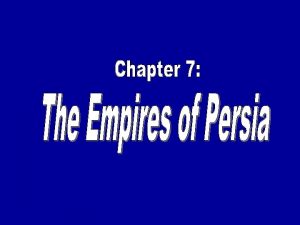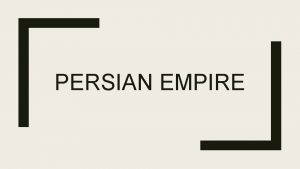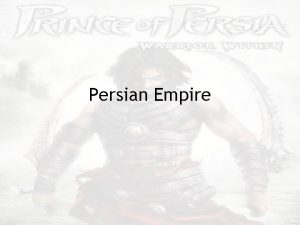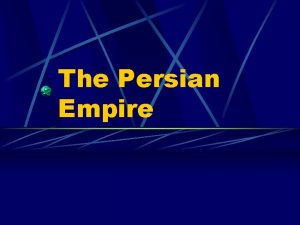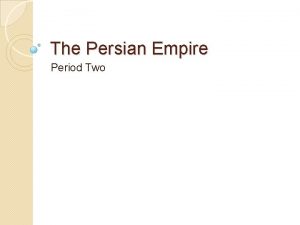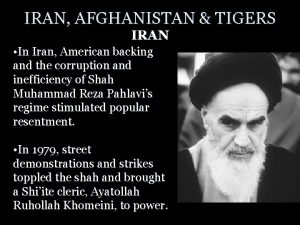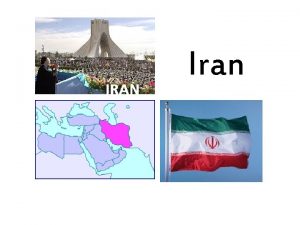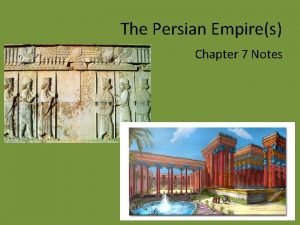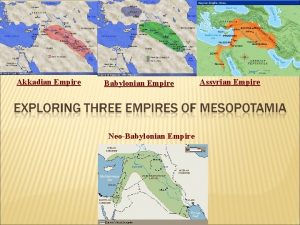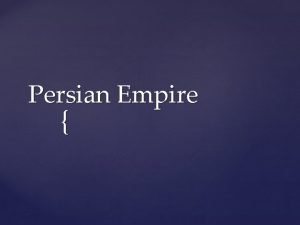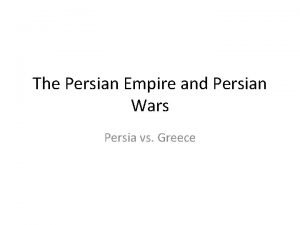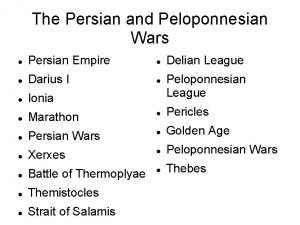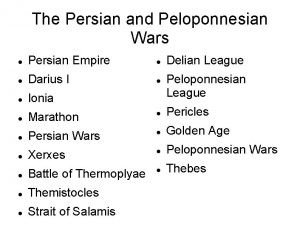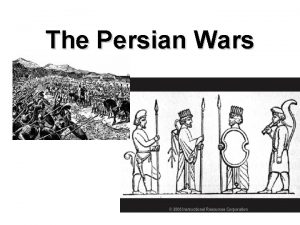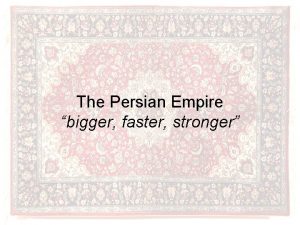The Persian Empire Persian Empires Contemporary Iran Four


























- Slides: 26


The Persian Empire

Persian Empires �Contemporary Iran �Four major dynasties �Achaemenids (558 -330 BCE) �Seleucids (323 -283 BCE) �Parthians (247 BCE-224 CE) �Sasanids (224 -651 CE)

Achaemenid Empire (558 -330 BCE) �Migration of Medes and Persians from central Asia, before 1000 BCE �Indo-Europeans �Capitalized on weakening Assyrian and Babylonian empires � POWER VACUUM �Peak under Darius (r. 521 -486 BCE) �Ruled Indus to the Aegean �Capital Persepolis

Cyrus the Great Founder of dynasty “The Tolerant” Iranian artists rendition of Cyrus the Great 559 – 529 BCE

The Cyrus Cylinder, sometimes described as the "first charter of human rights"

Darius I (the Great) 522 – 486 BCE As portrayed on a Greek vase


§Tax collecting § Projects § Satraps § The King’s eyes and ears §Royal Road § 1500 miles of road to encourage trade § Rapidly moving troops § Courier service § Postal stations § Caravanserai §Common currency


Persepolis Gate of Xerxes at Persepolis



The People of Persepolis

Persian Archers & Soldiers

Qanat System Wind tower and qanat used for cooling. By 400 BCE Persian engineers had already mastered the technique of storing ice in the middle of summer in the desert in naturally cooled refrigerators called yakhchal (meaning ice pits) which were connected to qanats. .

Decline of the Achaemenid Empire �Xerxes 519 – 465 BCE �Policy of toleration over �Costly wars with Greeks �Increasing public discontent over taxes


Persian Wars (500 -479 BCE) �Rebellious Greeks in Ionia �Peninsular Greeks join in �Persians defeated at Marathon (490 BCE), retreated, ending the first phase of the Persian Wars �Upon the death of Darius, his son Xerxes I assembled one of the largest militaries ever to invade Greece again in 480 BCE �In 479 BCE at the Battle of Plataea, the Persians were defeated for the final time in Greece. �Further Greek revolts took place of the next 25 years.

Seleucid Empire, 305 – 83 BCE �Weakened Achaemenids, divided Greeks �Phillip II of Macedonia


https: //www. youtube. com/watch ? v=0 Lsrk. WDCvxg

Antigonus Seleucus Ptolemy

Parthian Empire �Seminomadic Parthians drive Seleucus out of Iran �Federated governmental structure �Especially strong cavalry �Alfalfa fed horses grew larger than steppe ponies and enabled heavy armor �Weakened by ongoing wars with Romans �Fell to internal rebellion of feuding satraps

Sasanid Empire (224 -651 CE) �Claimed descent from Achaemenids �Continual conflicts with Rome, Byzantium in the west, Kush in the east �Overwhelmed by Arab conquest in 651 �Persian administration and culture absorbed into local Islamic culture

The Parthian and Sasanid Empires, 247 BCE-651 CE
 Maritime empires vs land empires
Maritime empires vs land empires The persian empire chapter 4 section 3
The persian empire chapter 4 section 3 Chapter 4 section 3 the persian empire
Chapter 4 section 3 the persian empire How did cyrus treat the people he conquered
How did cyrus treat the people he conquered Persian empire primary sources
Persian empire primary sources The rise of the persian empire
The rise of the persian empire The persian empire chapter 4 section 3
The persian empire chapter 4 section 3 Persian empire golden age
Persian empire golden age How did persian rulers unite their vast empire?
How did persian rulers unite their vast empire? Persian empire trade routes
Persian empire trade routes Empire
Empire Four empires of mesopotamia
Four empires of mesopotamia Mauryan empire and gupta empire venn diagram
Mauryan empire and gupta empire venn diagram American empire vs british empire
American empire vs british empire Rich and poor romans
Rich and poor romans Four contemporary economic issues
Four contemporary economic issues Dba iran
Dba iran Alborz darou pharmaceutical co
Alborz darou pharmaceutical co Voy vas va vamos vais van
Voy vas va vamos vais van Alabanza el rapto de la iglesia
Alabanza el rapto de la iglesia Oliver north iran contra affair
Oliver north iran contra affair Ang namumuno sa bansang iran upang makamit ang kalayaan
Ang namumuno sa bansang iran upang makamit ang kalayaan Imperial crown jewels of iran
Imperial crown jewels of iran Iran construction engineering organization
Iran construction engineering organization Plastic omnium h300
Plastic omnium h300 Iran cat map
Iran cat map Ey iran national anthem
Ey iran national anthem


